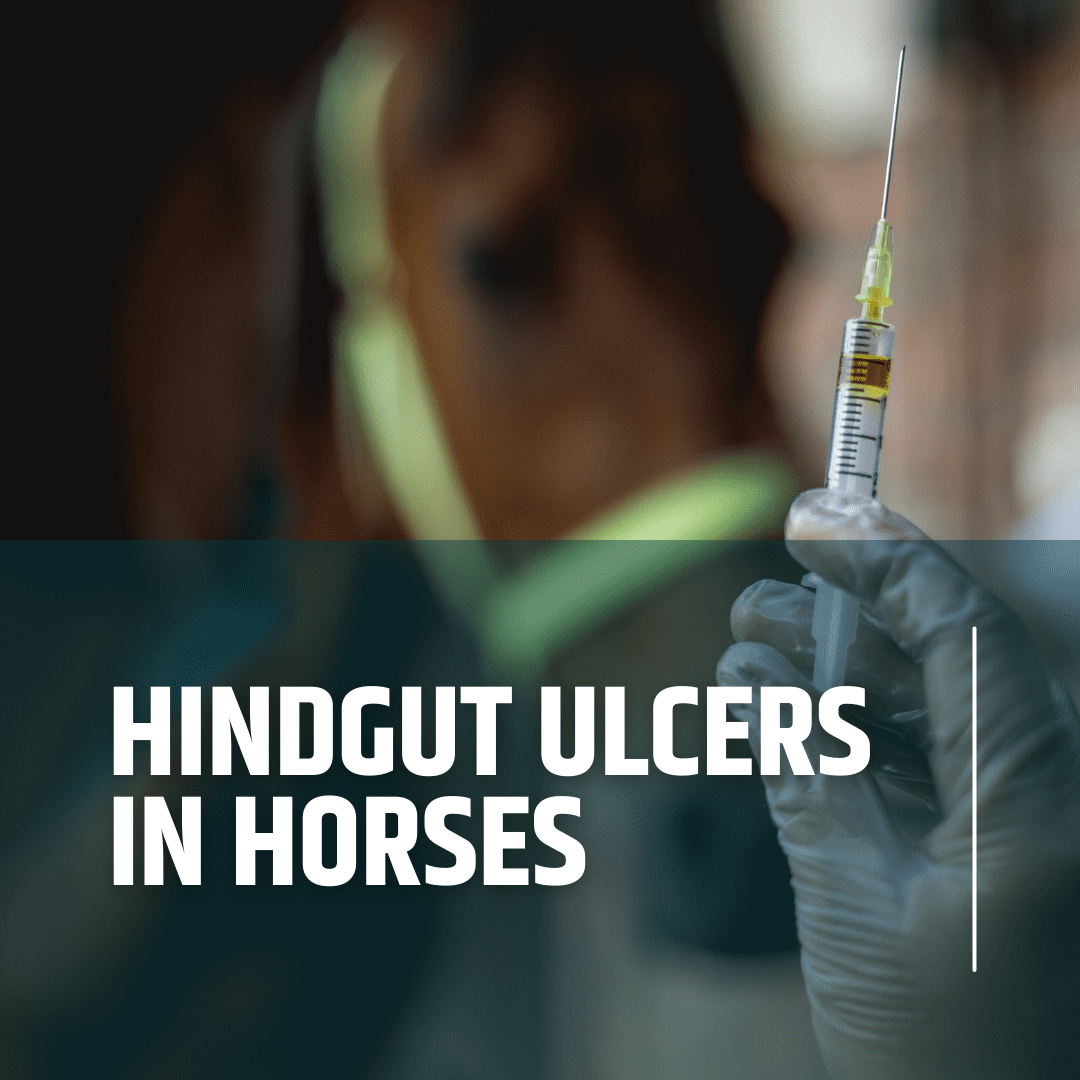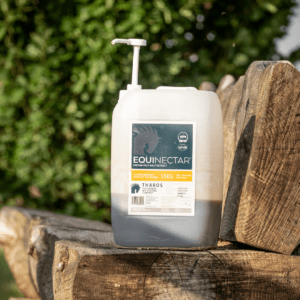

Ben Nedas
Chief Commercial Officer
Hindgut Ulcers in Horses
01
Can you diagnose hindgut ulcers?
Diagnosing hindgut ulcers in horses presents unique challenges. Unlike gastric ulcers that can be identified using gastroscopy, hindgut ulcers are more elusive.
The hindgut's location and length make it inaccessible to standard scoping techniques. Additionally, current imaging technologies do not effectively reveal ulcers in this region.
Hindgut ulcers are a complex and often underdiagnosed condition in veterinary medicine. Unlike gastric ulcers, which are relatively easier to diagnose due to the direct visualisation of the stomach lining, hindgut ulcers are not as easily detected. This is because the hindgut, which includes the cecum and colon, is located deeper within the horse's abdomen and cannot be directly observed without invasive procedures.
As a result, vets often have to rely on indirect signs and symptoms to diagnose hindgut ulcers. These signs may include changes in behaviour, such as increased irritability or aggression, decreased appetite, weight loss, poor performance, and changes in manure consistency. Horses with hindgut ulcers may also exhibit signs of colic, such as abdominal pain, pawing, rolling, or lying down more frequently.
To further complicate matters, these signs and symptoms can be nonspecific and overlap with other gastrointestinal issues, making it challenging for vets to pinpoint the exact cause. Additionally, hindgut ulcers can vary in severity, with some horses showing mild symptoms while others experience more severe complications.
In order to diagnose hindgut ulcers, vets may perform a thorough physical examination, including palpation of the abdomen to check for any abnormalities or discomfort. They may also conduct blood tests to assess for any changes in blood cell counts or electrolyte imbalances. However, these tests alone are not definitive and may only provide supportive evidence.
To obtain a more accurate diagnosis, vets may recommend further diagnostic procedures, such as endoscopy or ultrasound, to directly visualise the hindgut and assess for any ulcerations or abnormalities. However, these procedures can be invasive and require specialised equipment and expertise.
Due to the challenges associated with diagnosing hindgut ulcers, it is not uncommon for this condition to be underdiagnosed or misdiagnosed. This can lead to delayed treatment and potentially worsen the horse's condition. Therefore, it is crucial for horse owners and vets to be aware of the signs and symptoms associated with hindgut ulcers and consider them as a potential cause when evaluating a horse's health and performance.
02
How common are hindgut ulcers?
The prevalence of hindgut ulcers in horses, particularly when considering different types of horses, is striking. In a significant necroscopic study by Pellegrini [1], the occurrence of colonic ulcers was investigated across various equine populations. The study encompassed over 500 horses, with a notable distinction made between performance horses and non-performance horses. The findings revealed a stark contrast in prevalence rates:
Performance Horses: Among this group of 180 horses, which includes racehorses and other competition horses, the incidence of colonic ulcers was found to be alarmingly high. Approximately 63% of performance horses in the study had evidence of colonic ulcers.
Horses of varied types and sources: This group of 365 horses exhibited a lower prevalence rate, with around 44% showing signs of colonic ulcers.
These statistics highlight the significant impact of activity and lifestyle on equine gastrointestinal health. The elevated rate of hindgut ulcers in performance horses underscores the stress and dietary challenges these animals often face. This contrast also emphasises the importance of tailored management and preventive strategies for different categories of horses, ensuring their wellbeing and longevity.
03
Hindgut acidosis
Hindgut acidosis is relatively common among horses, particularly those on high-grain, low-forage diets [2]. However, it’s important to realise that rich grass is also a likely cause.
This condition can happen with or without hindgut ulcers and causes a decrease in the pH of the hindgut. Interestingly, the management and treatment of hindgut acidosis remain largely consistent regardless of the presence of ulcers. The focus is typically on restoring and maintaining a balanced gut environment [3].
04
Signs of hindgut acidosis
The health of a horse's hindgut is intricately linked to various observable factors, with faecal pH and consistency being primary indicators. A low faecal pH and alterations in droppings' consistency often suggest hindgut acidosis, potentially stemming from an imbalanced gut microbiome [4]. However, these are not the only signs to watch for. Hindgut acidosis can manifest in several other ways, particularly affecting a horse's temperament and movement.
Temperament Changes: Horses suffering from hindgut acidosis may exhibit noticeable changes in temperament. This could range from increased irritability and anxiety to a general decrease in responsiveness. Such behavioural shifts are often a horse's way of communicating discomfort or distress caused by digestive issues.
Discomfort During Movement: Physical signs, particularly those related to movement, can also be indicative of hindgut issues. Horses might show signs of discomfort or reluctance during exercise, especially when engaging in activities that typically involve flexing or turning. This discomfort can stem from the pain or irritation in the hindgut area, exacerbated by physical activity.
Overall Health Indicators: It's also important to consider overall health indicators such as changes in appetite, weight loss, or a general decline in condition. These signs, coupled with altered faecal characteristics and temperament changes, provide a more comprehensive picture of a horse's hindgut health.
Observing these various aspects can guide horse owners and vets towards a more accurate assessment of hindgut health and the potential presence of hindgut acidosis. Prompt recognition and intervention are key to managing these conditions effectively, ensuring the wellbeing of the horse.
Learn more about the role of the hindgut and its significance to equine digestion.
05
Treatment
The treatment of hindgut ulcers and acidosis primarily revolves around dietary adjustments and supportive care. This includes increasing forage intake, reducing grains, and providing a stress-free environment. In some cases, vets may prescribe medications to support gut health and alleviate symptoms.
06
Prevention: focusing on the gut microbiome
Preventing hindgut issues is largely centred around optimising the gut microbiome. This involves feeding practices that promote a healthy balance of microflora in the hindgut. High-forage diets, regular feeding schedules, and minimising stress are key strategies in maintaining a healthy gut environment [3]. If forage choices are contributing to the problems, change forage source.
07
Supplements
- Probiotics: The effectiveness of probiotics in managing hindgut acidosis is still a topic of debate. Adding good bacteria to the horse's gut may help, but there isn't much scientific proof of its effectiveness.
- Prebiotics: Similarly, prebiotics, which are designed to feed the beneficial bacteria in the gut, have shown mixed results. In some cases, they might exacerbate gastric issues instead of alleviating them.
- EquiNectar: EquiNectar stands out as an effective digestive supplement for horses. It optimises the gut microbiome. It contains digestive enzymes that work in the small intestine, reducing undigested starch and fructans from reaching the hindgut. This action not only balances but also optimises the hindgut microbiome, reducing the number of lactate-producing bacteria.
08
Feeding suggestions
When hindgut acidosis is suspected, dietary management is crucial. The focus should be on:
- Increasing forage intake to ensure a fibre-rich diet.
- Assessing pasture, hay and haylage to determine if there are problematic grass varieties or if fructan levels are too high.
- Limiting grain and concentrates that can ferment in the hindgut.
- Providing small, frequent meals to maintain a stable gut environment.
- Ensuring access to clean, fresh water.
Diet plays a pivotal role in maintaining hindgut health, and these feeding practices are fundamental in both treatment and prevention of hindgut acidosis.
09
Is EquiNectar useful for my horse?
In the context of hindgut ulcers and acidosis, EquiNectar can be a valuable addition to your horse's diet. By providing essential digestive enzymes, it aids in more efficient digestion in the small intestine. This reduces the risk of undigested starches and fructans fermenting in the hindgut. EquiNectar's role in rebalancing and optimising the gut microbiome further contributes to overall gut health, making it a beneficial supplement.
References
ABOUT EQUINECTAR
Description
EquiNectar® is a natural feed supplement, that is scientifically proven to:
- Re-balance your horse’s gut bacteria
- Help your horse maximise benefits from its feed
- Improve your horse’s condition
More information
EquiNectar® is produced by Tharos Ltd in the UK. It is a natural source of digestive enzymes and contains only the following ingredients:
- Our patented enzyme rich malt extract
- Medium chain triglycerides (from coconut oil)
- Potassium sorbate
For more details of the enzymes within EquiNectar® take a look at the ingredients and enzymes page.
How to feed
Simply add EquiNectar® to your horse's daily feed, using the Feeding Rate chart to determine the correct amount.
For detailed instructions about how to introduce EquiNectar, please read the comprehensive Feeding Guide page.





